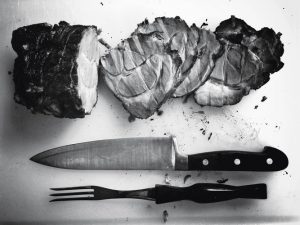Chef Knives Part Two: High Carbon Stainless Steel vs Straight Carbon
Notes: This is a continued topic from my article last week “Chef Knives: What Do The Professionals Use?” So, if you have any questions about the content or persons mentioned, please refer to my previous article. Thank you!
 So, now that we know what some of our beloved local professionals use in their kitchens, you have enough knowledge to go out and find your own knives, right? Well, yes, but there are other factors to consider, like the pros and cons of a specific metal over another. While it is a given to go and buy a really nice stainless steel Chef knife, there are also carbon Chef knives to look at, but what is the difference? Well, before the late 1970s to early 1980s full carbon Chef knives were in full swing, they hold a great edge, they hold that edge for quite some time, and they are durable despite the harder metal; after the aforementioned years Chefs started phasing out the use of carbon knives for that of stainless steel. In comparison to carbon, stainless might not have an edge life like that of carbon, but it is easier to take care of because of the included metals. To be corrosion and rust resistant a Chef knife requires at least 10.5% Chromium, but this doesn’t mean they are impervious, prolonged exposure can still cause the blade to rust or degrade in general. Carbon knives lack that included Chromium, so they are susceptible to rust and corrosion, especially if you are cutting highly acidic foods you will see a change in the metal within minutes of the task; while this does sound concerning it is not difficult to prevent, just wipe off the knife after every use, and when you are storing it away give the blade a decent layer of food grade oil. Whether it is a stainless steel knife or a carbon, be sure to not leave your knife in a sink of water not just because that is extremely dangerous, it will also cause harm to your knife.
So, now that we know what some of our beloved local professionals use in their kitchens, you have enough knowledge to go out and find your own knives, right? Well, yes, but there are other factors to consider, like the pros and cons of a specific metal over another. While it is a given to go and buy a really nice stainless steel Chef knife, there are also carbon Chef knives to look at, but what is the difference? Well, before the late 1970s to early 1980s full carbon Chef knives were in full swing, they hold a great edge, they hold that edge for quite some time, and they are durable despite the harder metal; after the aforementioned years Chefs started phasing out the use of carbon knives for that of stainless steel. In comparison to carbon, stainless might not have an edge life like that of carbon, but it is easier to take care of because of the included metals. To be corrosion and rust resistant a Chef knife requires at least 10.5% Chromium, but this doesn’t mean they are impervious, prolonged exposure can still cause the blade to rust or degrade in general. Carbon knives lack that included Chromium, so they are susceptible to rust and corrosion, especially if you are cutting highly acidic foods you will see a change in the metal within minutes of the task; while this does sound concerning it is not difficult to prevent, just wipe off the knife after every use, and when you are storing it away give the blade a decent layer of food grade oil. Whether it is a stainless steel knife or a carbon, be sure to not leave your knife in a sink of water not just because that is extremely dangerous, it will also cause harm to your knife.
Let’s go back to our list of local professionals, as the list provided in my last article gave a decent array of the different knives out there, and the metals used for each knife.
Chef Dylan, Smorbrod- Shun Kanso 7” Santoku
Chef Tony Shaffer, The Purple Toad- Richmond Artifex Carbon Steel Gyuto
Chef Izzy, The Salty Sow- Tojiro Chef knife
Chef Caitlin Knight, N/A- Zwilling Four Star 8” Chef knife
Chef Tommy Graves, Hustle & Heart Hospitality- Messermeister Four Seasons Chef knife
Chef Jamie Dahlin, Mr. Helsinki Wine Bar and Art Gallery- Zwilling Pro 8” Chef knife
Chef Jeremiah Gray, Moxie- Wusthof Legende 8” Chef knife
While this list does not give many examples of carbon knives aside from Tony, I will include one from my own collection, the recently discontinued Shun Blue Carbon 8” Kiritsuke. Aside from Tony’s carbon Gyuto, the rest of the list is a good assortment of stainless metals; we will pick at the Wusthof knives as they are quite popular, and the knives made by Shun, as these two are good examples of different builds based on the country of origin.
I will be providing a link to the Wiki page as it gives a good amount of info on the different metals provided below, so you can follow along there if you see fit. I would go through and talk about the knives made by Zwilling, but they keep the specific metal under wraps other than a few abbreviations of the steel and the process used, sorry guys. Anyway, your typical German knives such as Wusthof utilize X50CrMo14 for their knives, which is similar to 425M, so it easy to sharpen and maintain. Due to the softer metal, they do require regular stone sharpening sessions, this does not include honing as that should be done before and after every use; if you do not know how to use a stone I do recommend it as this will definitely prolong the life of your kitchen knives. Aside from being a softer metal, the blade itself is rust and corrosion resistant, so you don’t have to worry about any issues if you are slicing a couple tomatoes. Do be careful with your stainless steel blades though, as they can easily show every possible scratch they are given, no doubt benefiting the personality of your knives, but a thought nonetheless. Unless, you buy yourself the same knife as Dylan Montanio, a Shun Kanso 7” Santoku, or any knife of the Shun Kanso line as they are all provided with the same heritage style blade. The heritage finish on the blade is designed to hide scratches and give the knife a more rustic look that only improves with age, so if you are skeptical of your knives showing scratches I would recommend you give these a look.
Going on with the Shun made knives, my go to Shun is the recently discontinued Shun Blue Carbon 8” Kiritsuke, you can still find the full array of this line at Sparrowhawk on Tejon, the knives themselves are on a “bye bye blue” sale, so be sure to check them out if the carbon knives interest you. Be careful though, as mentioned above, carbon does require extra care. The easiest way to take care of a knife like this is to always have a rag handy when prepping food, purchase a care kit (Shun has one with sticks of varying grades of polishing and so on, costs about $25), and find a stone that works best for you. These items will not only help you maintain the life of your knives, but teach proper knife care. As an example, if you are slicing tomatoes or a citrus fruit, have a rag handy as to wipe the blade immediately after use, if you don’t you will notice the blade will turn color within a few minutes, to counteract this clean the blade then use a rough sponge as needed. When you buy a knife like this, do not worry the first time you use it. The first time I used this [Shun Blue] knife I watched the blade develop its patina, which is a reaction between the acids and the metal to protect against corrosion, and it really freaked me out. You will notice the metal of a knife like this, or various carbon steels, shift from light to dark patinas based on the use and the type of metal; it takes a little extra knowledge to take care of a knife like this, so be prepared. Let’s summarize.
High Carbon Stainless Steel-
Pros:
- Corrosion and rust resistant
- Holds a good edge
- Easy to sharpen
Cons:
- Softer metal
- Requires frequent sharpening sessions
Straight Carbon Steel:
Pros:
- Holds a sharp edge, harder metal
- Easy to Sharpen
- Patina protects against acidic foods
Cons:
- No corrosion or rust resistance
- Can chip based on use
While these are only a few of the pros and cons between the two different metals, it is important you go and find what works best for you, be it high carbon stainless or straight carbon. Despite your choice the knife will require consistent care, but will inevitably take on your personality, and it is a good feeling to see something like that.
Wiki Link:https://en.wikipedia.org/wiki/List_of_blade_materials
Image used: https://unsplash.com/photos/XLxhM6UH4pA
Social Media: Instagram- @caileananderson
Facebook- Cailean Anderson
E-Mail- cailean_anderson@protonmail.com








